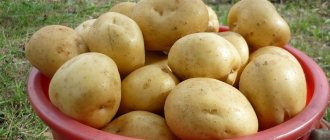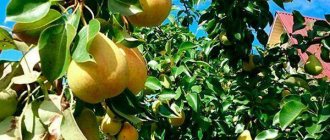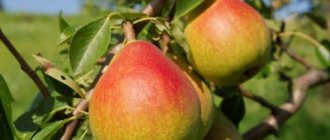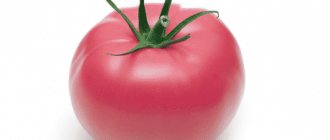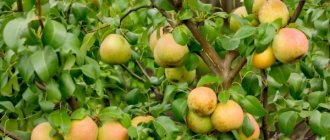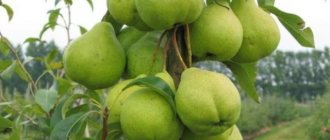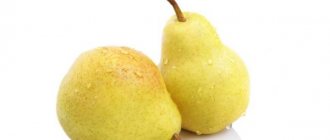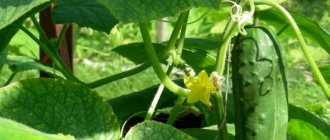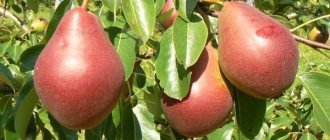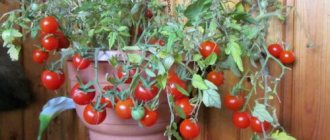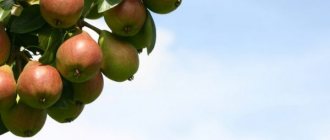Description and characteristics
Chizhovskaya trees are characterized by medium size. Their height in most cases does not exceed 2.5 meters. Closed, well-leafed shoots form a dense crown. The bark of the trunk is deep gray, the branches are lighter.
Chizhovskaya fruits are medium-sized and have a classic pear shape. The color of pears is yellow-green with a slight rustiness. The pulp is cream-colored, with average juiciness and a characteristic delicate aroma.
Even after full ripening, the fruits remain on the tree for a long time, which makes harvesting much easier. If the conditions are created, the fruits can be stored for up to 4 months.
According to the description of the variety, the Chizhovskaya pear is cross-pollinated. Therefore, it is necessary to plant pollinators nearby. For example, you can use Rogneda, Lada.
Photo. Young Chizhevskaya tree
The late summer variety was obtained at the Moscow Agricultural Academy named after. K. A. Timiryazeva from crossing the Olga and Lesnaya Krasavitsa varieties. Authors: S. T. Chizhov, S. P. Potapov. Included in the State Register in 1993 for the Central, Middle Volga and North-Western regions. Widely distributed in the Moscow region.
Tree
standard type, medium height. The crown at a young age is narrow, when fruiting it is pyramidal (cone-shaped), dense, and the foliage is medium. The color of the bark of the trunk is dark gray. The skeletal branches are gray, located obliquely and vertically. Fruiting is ring type.
Escapes
dark or reddish brown, slightly curved, medium length and thickness, round in cross-section. Internodes are of medium length, without pubescence, lentils are small, sparse, located at surface level. The buds are cone-shaped, slightly deflected, dark brown. The leaf is medium-sized, elongated-oval, often elongated, green, curved along the central vein. The leaf blade is elastic, of medium thickness, the surface is smooth, the edge of the leaf is serrated, there is no pubescence on the upper and lower surfaces. Petiole of medium length. Stipules are lanceolate. The flowers are medium-sized, cup-shaped, the corolla is white, the edge of the petals is whole, the closeness of the petals is average. The buds are white. The inflorescence is a corymbose raceme. Average number of flowers (5-7).
Fruit
medium size, weighing 120-140 g, obovate or pear-shaped, smooth surface. The skin is thin, smooth, matte, dry. The main color is yellow-green. The integumentary coloration is absent or very weakly expressed in the form of a blurred pink blush. Subcutaneous points are small, moderately expressed. The rustiness is weak, delicate. The peduncle is short, of medium thickness. The funnel is small, narrow, ribbed. The saucer is small, narrow, lumpy. The calyx is open. The subcup tube is medium in size. The axial cavity of the fruit is medium. The heart is broadly oval, small, without granulations. The number of seeds in the fruit is average (5-10 pieces), the seeds are medium-sized, brown. The pulp is light yellow or almost white, medium-juicy, semi-oily, melting, slightly aromatic, with a good sour-sweet refreshing taste. Tasting taste score 4.1-4.2 points. The appearance of the fruit is attractive. Chemical composition of fruits: 16.5% dry substances, 13.1% soluble substances, 9.1% sugars, 0.45% titratable acids, 166 mg/100g P-active substances. The variety is mid-season, late summer. The maximum shelf life of fruits is 60-120 days at 0°C. Fruit shedding is weak. Transportability is average, fruit marketability is high. A variety for universal use. Almost self-fertile. The best pollinating varieties: Lada, Severyanka, Rogneda. Early fruiting, begins to bear fruit 3-4 years after grafting. Yield per tree up to 50 kg. Fruiting is regular. Winter hardiness is very high. Scab resistant. Highly resistant to extreme environmental conditions and diseases.
Advantages of the variety:
high winter hardiness, early fruiting, good appearance of the fruit.
Disadvantages of the variety:
fruit shrinkage as the tree ages.
Landing Features
The variety grows well and bears fruit on moderately fertile soils with a slightly acidic reaction. If the reaction is too acidic, lime must be added. The area intended for planting is pre-fertilized with humus with the addition of mineral fertilizers. For example, you can use superphosphate and potassium chloride.
Attention! Fertilizer application rates should be looked directly at the packages recommended by the manufacturer. They must be strictly observed.
Laying the planting hole
When choosing a place to lay a planting hole, the following requirements must be taken into account:
- at least 3 meters from buildings;
- 3-4 meters to other large fruit trees;
- absence of a slope steeper than 10°.
When digging a planting hole, the excavated soil is divided into 2 piles:
- the upper, looser, fertile layer is folded into the first;
- in the second - the lower layer of soil.
The depth of the pit must be at least 60 cm, the diameter must be at least a meter.
Before planting a seedling, the pit must be filled with fertilizers; you will need:
- 2-3 buckets of well-rotted humus;
- 1 kg of superphosphate;
- 150 gr. potassium sulfate;
- 800 gr. wood ash.
Humus and all fertilizers are thoroughly mixed with the soil removed from the hole.
Attention! Nitrogen negatively affects the rooting process. Therefore, nitrogen-containing fertilizers are not used during planting.
Landing
Before planting, pear seedlings carefully inspect the root system. All damaged areas are cut back to healthy tissue. The more strongly developed roots, the faster the seedling will take root in a new place.
The landing process is as follows:
- The roots are dipped in clay mash.
- The seedling is placed in the planting hole, carefully straightening its roots. The root collar cannot be buried. It should be at ground level.
- The hole is filled with earth; it is necessary to ensure that there are no voids.
- After planting, the seedlings are well watered.
- After watering, the soil surface must be mulched with a layer of straw or peat.
Features of cultivation
Planting location and soil requirements
In order to always have good harvests, you need to choose the right place to plant a seedling of this variety:
- The Chizhovskaya pear variety grows well on loams and black soils.
- Trees cannot withstand flooding by spring meltwater or groundwater.
- You cannot plant seedlings of this variety in an area where there are more than 4 sow thistle or milkweed plants per 1 m2.
- The area should be illuminated by sunlight and protected from gusty winds.
- The soil should be fairly level and homogeneous. Wetlands are not permitted.
- To increase the number of pollinated flowers, you need to place a seedling nearby (20-25 m) from the following varieties: Severyanka, Rogneda, Lada.
Selection of seedlings
The level of the future harvest and the degree of development of the tree largely depends on the choice of high-quality and viable planting material:
- Seedlings of the first and second years take root well.
- The height of the seedling must be at least 90 cm.
- The seedling must be smooth and without signs of various diseases or pests.
- The roots should be well developed, consisting of 1-2 central well-developed roots and many secondary roots.
- The presence of various mechanical damages and broken branches on the seedling is not allowed.
- Using a garden knife, you need to make a small cut on the central root and stem of the seedling. In this case, through the incisions you need to make sure that the subcortical tissues have a light color and a moist structure.
Seedling preparation
The day before planting, the seedling needs to be properly and efficiently prepared:
- Remove all leaves on the branches.
- The branches, the top of the seedling and the root system are shortened by 2.5-3 cm.
- Soak the roots in 10 liters. water with 20 ml. growth regulator Vympel and Energen Aqua fertilizer (15 ml.).
Planting a seedling
The variety should be planted in autumn (September). The entire planting process is carried out as follows:
- 4-5 weeks before planting the seedling, a planting hole with a volume of 75 x 75 x 70 cm is dug.
- The tree planting pattern should be 6 x 7 cm.
- A day before planting, 5-7 kg are placed in the pit. compost or 5-6 kg. rotted manure, 150 g ammophos, 50-60 g wood ash.
- Using a shovel, mix fertilizers with the soil. Pour 15-20 liters. water.
- A wooden peg is driven in the middle of the hole and a seedling is placed next to it.
- The roots of the seedling are spread out to the sides and covered with soil.
- The planted seedling is tied to a wooden peg and additionally watered with 13-15 liters. water.
Watering
Trees should be watered according to the following scheme:
- After planting, the seedling is watered every 3 days with a norm of 9-10 liters in the first 4 weeks. water for each tree.
- From the spring of the second year, young trees are watered once a week. The irrigation water consumption rate is 15-20 l. for every tree.
- In 3-4 years, you can water no more than once every two weeks. In this case, the volume of irrigation water must be increased to 25-30 liters. per one tree.
- From the fifth year of cultivation, watering should be carried out only during the period of fruit set and growth. To do this, it is enough to water the trees once a week with a rate of 30-35 liters. water on the tree.
Weed control
Weeds, especially perennial ones, can greatly oppress seedlings in the first year of cultivation. Therefore, it is necessary to systematically destroy weed seedlings without giving them time to take root. In this case, the depth of soil loosening should be 3-4 cm.
Trimming
High-quality and timely pruning is very important for this variety:
- Pruning is carried out in mid-March.
- On seedlings planted last fall, all branches are shortened by 1/3.
- Remove dried branches and shoots.
- If the crown of the tree is thickened, then it is necessary to thin it out and remove shoots. This leads to an increased flow of sunlight to all parts of the crown, which has a positive effect on the harvest.
- Shoots that grow parallel to the ground or in the middle of the crown are removed, thereby suppressing other parts of the crown.
Top dressing
During the year of planting, seedlings do not need fertilizing. But starting from the second year of cultivation, fertilizing is a very important event. With fertilizing, trees receive in full all the necessary nutrients that they need to form a good harvest of fruits. Many gardeners recommend the following feeding scheme for this variety:
- Before sap flow begins in mid-March, 50-60 g of urea per 1 m2 is scattered around the tree. Such fertilizing is carried out only on the condition that the soil surface is sufficiently moist.
- In early April, a furrow 13-14 cm deep is made around the tree at a distance of 1-1.5 m from the trunk and 4-5 liters are added into it. chicken manure solution. Chicken manure is diluted with water in a ratio of 1:13.
- Before flowering begins, the pear crown is treated with a solution consisting of 10 liters. water and 30 g of crushed nitroammophoska.
- After flowering is completed, treat with Energen Aqua at a dose of 23-25 ml per 10-11 liters. water.
Pest Control
The greatest damage to trees and fruits of this variety is caused by aphids, pear moths and pear bugs. Aphids suck cell sap from leaves, thereby weakening trees and slowing down their development. Control measures:
- Systematically weed the area around the trunk.
- Tear off loose bark.
- Every year, whitewash the trunk and skeletal branches with lime.
- Before the buds open, you need to treat the trees with the Call preparation (0.5-0.7 liters per 8-9 liters of water).
- After the buds open and colonies appear on the trees, you need to spray the trees with the Aktara insecticide (4-5 g per 7-8 liters of water).
The pear moth damages fruits by making tunnels in them. The pest concentrates in the center of the fruit, where it completely eats up the seeds. Control measures:
- Collection and subsequent destruction of fallen infected fruits.
- The tree trunk circle is dug up twice a year.
- Spray infected trees with the insecticide Agravertim before and after flowering.
The amount of use of the drug is 20 ml. drug for 6 l. water. The pear bug, like the aphid, feeds on the cell sap of leaves. Control measures:
- After the end of leaf fall, the leaves are collected and burned.
- Remove loose bark from the tree.
- Treatment of the crown with the insecticide Chlorophos.
Diseases and the fight against them
The greatest damage to trees of this variety is caused by fruit rot, cytosporosis and rust. Fruit rot appears on pear fruits in the form of brown spots. After 1-2 weeks, growths of spores form on the affected fruits. The pulp becomes soft, acquires a brown tint and an unpleasant aftertaste. Control measures:
- Removing and burning infected fruits.
- In spring and autumn, spray the tree with a lime solution (10 liters of water + 2 kg of lime).
- After harvesting, the trees are sprayed with copper sulfate (95-100 g per 8-10 liters of water).
Cytosporosis is a fungal disease and can affect the main branches along the entire diameter of the crown. At the same time, the bark on the tree begins to dry out, which can cause the death of the branches and the entire tree as a whole. Measures to combat the disease:
- Removing all affected areas on the branches.
- In the fall, they burn fallen leaves and dig up the space around the trunk.
- Before the buds open, the trees are sprayed with a 2% solution of the fungicide Nitrofen or a 3% solution of Bordeaux mixture.
- During the period of fruit filling, a solution of copper oxychloride is used (18-20 g of the drug per 9-10 liters of water)
- After flowering is completed, the trees are sprayed with 2% Bordeaux mixture.
Trees affected by rust are distinguished by the presence of red-orange spots on the leaves. These leaves gradually dry out and fall off. Control measures:
- Destroying fallen leaves and digging up the soil around the tree trunk.
- Spraying trees with fungicide Skor (2-3 ml per 10 liters of water) three times a season: before buds open, before flowering, after flowering.
Harvesting
Harvesting begins at the end of August. To remove ripe fruits, stepladders, special poles and other devices are used. The fruits need to be picked in dry weather along with the stalks. The harvested crop is best stored in wooden boxes. At the same time, in a room adapted for long-term storage of fruits, the air temperature of +2 degrees is optimal.
Wintering
Preparing a tree for wintering is very important for the future harvest. Starting from September, the following events need to be carried out:
- They collect fallen leaves and burn them.
- Treat tree trunks and branches with Dnok or copper sulfate.
- In early October, trees are whitened with a lime solution, which protects the trunk from rodents and diseases. This solution is prepared by dissolving in 10 liters. water 1.5 kg. lime and 1 kg. clay.
- In the first year, seedlings need to be insulated in winter. To do this, the soil surface around the stem is insulated with bedding manure or dry peat. The trunk of the seedlings is wrapped with agrofibre or burlap.
Care
When caring for a pear tree of the Chizhovskaya variety, several basic points must be taken into account.
Watering
Mature Chizhovskaya trees tolerate drought well. But during the period of setting and filling the fruits, they need to be watered. If watering is not done, most of the ovary may fall off. Watering is carried out along the periphery; pouring water directly under the trunk is not recommended.
Removing overgrowth
In some cases, shoots begin to develop on pear trees below the grafting site. These are the so-called wild animals. If they are not removed in time, as they grow, they will begin to penetrate the crown. Over time, wild shoots can completely suppress a cultivated tree. When removing the shoots, they break them out or cut them out near the very base.
Fertilizer application
When applying fertilizers, be sure to take into account the growth rate of the tree:
- if the pear begins to bear fruit early, complex mineral fertilizers are applied;
- if a tree grows large shoots with huge leaves to the detriment of flowering and fruiting, it needs phosphorus-potassium fertilizers.
The general fertilizer application scheme is as follows:
| Payment deadline | Name | Quantity, gr. |
| Spring | Urea | 10-20 |
| Summer | Superphosphate | 20-30 |
| Autumn | Potassium sulfate | 20-30 |
If necessary, organic fertilizers can be included in the above scheme to stimulate growth. For example, humus can be used to mulch the tree trunk.
Trimming
Caring for the Chizhovskaya pear variety necessarily includes pruning. Its main purpose is to remove shoots growing inside the crown. This prevents thickening and increases yield. Pruning is carried out immediately after the snow melts, before the sap begins to flow. During the thinning pruning process, the following is cut out:
- all damaged, broken branches;
- shoots growing at an acute angle relative to the trunk.
Attention! After pruning is completed, all large cuts are covered with garden varnish.
Preparing for winter
Only 1-2 year old seedlings need special preparation for winter. After the onset of persistent cold weather, they are wrapped in several layers of covering material. This will protect the tender bark from frostbite.
Plant care
Watering
Chizhovskaya needs regular watering
The pear does not tolerate drought well and for full development the plant needs to be watered. During the first month after planting, the tree is moistened every 7–8 days. Then it is enough to water the pear 3-4 times a season.
Important! During one year of life, the crop should receive from 2 to 3 buckets of water, depending on climatic conditions.
Fertilizers
Chizhovskaya needs periodic feeding
To get a plentiful and high-quality harvest, the pear needs to be fed. The procedure is performed in several stages:
- The first fertilizing is applied during the flowering period. At this time, the tree needs nitrogen-containing fertilizers. To prepare the fertilizer, saltpeter is diluted with water in a ratio of 1:50. The solution is applied in a circle near the trunk. For 1 m² of soil you will need 30 g of saltpeter. You can also use urea: 80–120 g of the substance should be diluted in 5 liters of water. The amount of fertilizer is calculated for one tree.
- After flowering, nitroammophoska is added under the pear: 1 kg of the substance is diluted in 200 liters of water. For one tree you need 3 buckets of solution.
- The next feeding is carried out in the second half of June. During this period, nitrogen-containing compounds are also introduced. The procedure is performed in the same way as for spring feeding.
- With the onset of autumn, the pear begins to prepare for winter, and therefore needs mineral fertilizers. To prepare the mixture, you need to mix 2 tbsp. l. granulated superphosphate, 1 tbsp. l. potassium chloride and 10 liters of water. The solution is applied to the tree trunk circle. The number of components is indicated for 1 m² of soil.
Trimming
Pear needs pruning to form a crown
The next stage of crop care is pruning. The procedure is carried out to form the crown and provide the leaves with sunlight. Pruning is carried out in spring or autumn.
Important! In summer, the branches are not removed, since a lot of nutrients accumulate in them at this time. After pruning, the tree will lose these necessary elements. In winter, the procedure is also not performed, since in subzero temperatures the damaged areas will not be able to heal.
In spring, pruning begins when the average daily air temperature is set at +8 ° C. Branches that grow parallel to the trunk, are located at an angle of 90° and directed inward are removed from the tree. For the procedure, you can use a garden knife, saw, scissors or pruning shears.
Master class on spring pruning - video
In autumn, sanitary pruning is carried out, which involves the removal of diseased, non-fruit-bearing and old branches. The procedure is performed before the onset of frost - around October.
Damaged areas are treated with garden varnish. To prepare it, you need:
- Combine 50 g of pine resin, 250 g of grease and 200 g of wax.
- Place the container with these components on the fire until they are completely dissolved.
Gardeners often remove lower branches due to a lack of fruit, but this is a misconception. The most likely reason for the lack of pears is lack of light. And this problem can be solved by removing unnecessary branches.
Important! Proper pruning will help provide light to the lower layers of the tree.
Preparing for winter
This variety of pear is resistant to low temperatures. But shelter for the winter period will not be superfluous. You can start preparing from mid-October. The tree trunk circle is covered with vegetable tops and sprinkled with soil on top. Such an improvised blanket will help minimize the negative impact of snow cover on the tree.
Diseases and pests
Like other varieties, Chizhovskaya pear can suffer from pests and diseases.
| Title and description | Photo |
| Pear gall midge. Small brown insects similar to mosquitoes. They lay eggs in unopened buds. The hatched larvae massively damage the ovaries, which leads to their shedding. In the absence of timely treatment, the pest damages up to 50% of the fruits. To destroy gall midges, pears are sprayed with insecticide solutions during the budding phase. | |
| Pear moth. The adult form of the insect is a butterfly. The eggs laid by the fruit moth hatch into caterpillars that feed on the fruit. Damaged pears fall off and rot. For control, insecticides are sprayed at the beginning of summer. Loosening the soil in tree trunk circles and constantly collecting fallen leaves are also quite effective. | |
| Scab. A widespread fungal disease. It affects all parts of the tree, including fruits. Massive spread of the disease is observed in cool, rainy weather. For control, they are treated with fungicide solutions in early spring. |
Harvesting
The harvest of fruits from the Chizhovskaya variety begins in early September. Due to their low shedding, pears remain on the tree for a long time. Absolutely whole fruits are selected for storage. At temperatures close to zero, pears are well preserved for 2-4 months. The taste of the fruit only improves during storage. Overripe and beaten pears are used to make juice, compotes, and jam. Due to the high content of dry substances and pectin, pear blanks of this variety are perfectly gelled.
Harvest and storage
In the second half of August, the fruits are ready to eat. If the pear has been properly cared for, it will bear 50 kg of fruit. Fruits are collected carefully, especially if they are intended for long-term storage. The temperature in the storage room should be 0 ⁰C. Humidity no more than 70%. The pears are placed in wooden containers and sprinkled with sawdust or covered with newspapers.
Chizhovskaya pear is the best option for growing in the garden. Summer residents cultivate it due to the positive qualities that the tree is not deprived of.
